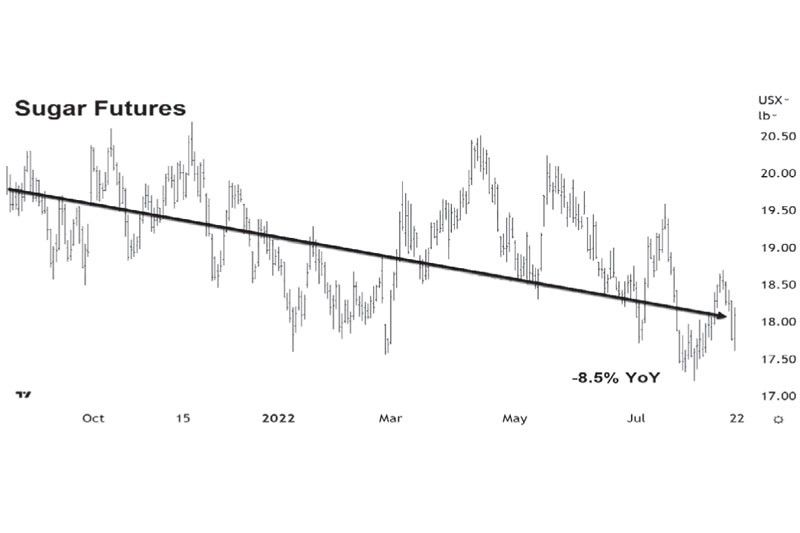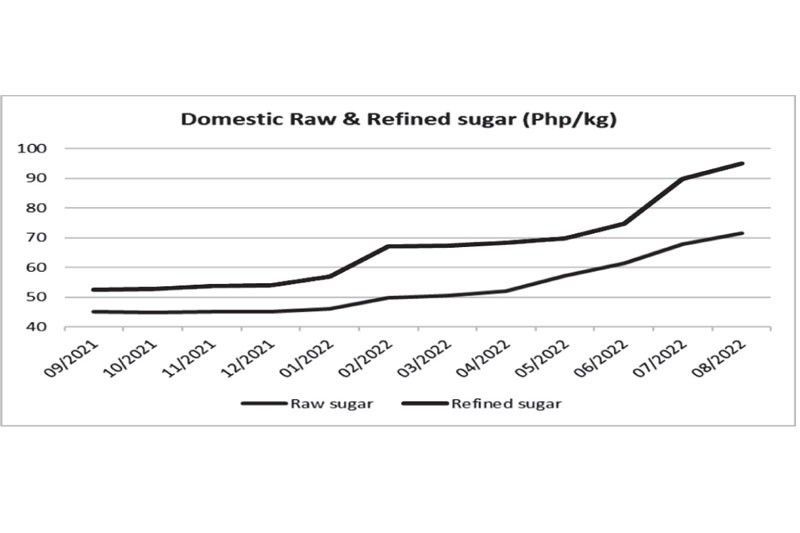Divergent sugar prices

Filipino consumers pay more for their sweetener compared to residents of most other countries. Despite being the 12th largest sugar producer in the world and historically producing more than enough for domestic needs, local sugar prices are kept relatively high in contrast to world sugar prices.
The Food Availability and Sufficiency report of the Philippine Statistics Authority (PSA) from 2010 to 2019 shows that the country’s self-sufficiency ratio for sugarcane is 100 percent. This means that the country’s supply of sugar is 100 percent covered by its domestic production. And yet, domestic sugar prices have diverged from international trading prices during the past decade. It reached up to twice the world market price and Thai export prices, according to “An Assessment of Reform Directions for the Philippine Sugar Industry,” a NEDA discussion paper published in 2021.
Wide price disparity
This year, the disparity in local and world sugar prices widened further. Driven by high fuel costs, a shortage of fertilizers, and disruptions in the supply chain, world sugar prices soared along with other agricultural commodities after Russia invaded Ukraine. However, prices of most agricultural products like wheat, corn, soybean oil, palm oil, and fertilizers have come down after hitting their peaks. Similarly, after an initial surge in March and peaking in April, sugar prices have stabilized and are back to pre-invasion levels. In fact, world sugar prices are lower by 8.5 percent year-on-year and 11.8 percent from their April peak.
Below is the chart of No. 11 Sugar futures contract traded at the Chicago Mercantile Exchange (CME). Sugar No. 11 is the world’s benchmark contract for raw sugar trading.

In contrast, domestic sugar prices have relentlessly climbed higher throughout the year despite fuel and fertilizer costs declining in recent months. According to the Sugar Regulatory Administration (SRA), the average price of raw sugar is P71.43 per kilo in public markets as of Aug. 5. It is up 59 percent over the past year. On the other hand, refined sugar in public markets sells at P95 per kilo, up 81 percent from the previous year. In some areas, refined sugar sells for as much as P115 per kilo, which is more than double the price a year ago.

Sugar shortfall
While many have blamed unfavorable weather, high fertilizer costs, hoarding by unscrupulous traders, and protectionism for the current sugar shortfall, what is evident is that sugar production is significantly lower this year. For the crop year 2021-2022, the actual output of raw sugar is 1,792,102 MT, and the production of refined sugar is 737,254 MT. Respectively, these are 15 percent and 12 percent lower than the previous four years’ average output, according to the latest SRA data.
An important industry
Despite its shortcomings, the sugar industry remains an integral part of the Philippine economy. Around 88,000 small to medium-scale sugarcane farmers cultivate 24 million metric tons annually. Sugarcane is the country’s fifth largest crop by value, after rice, bananas, corn, and coconuts, bringing in $815 million in 2020. Furthermore, the sugarcane supply chain – consisting of growers, millers, and associated logistics personnel – provides half a million jobs and generates P86 billion annually.
A balancing act
NEDA chief Arsenio Balisacan said that the cause of rising sugar prices is the insufficiency of current supply, adding that imports should be allowed if the local production cannot meet the demand. He noted the impact of soaring sugar prices not just on local producers but also for food manufacturers, SMEs, and other small vendors. Balisacan is also aware of the delicate balance that they, as economic managers, need to perform.
“There is a lot of employment that will be affected by soaring prices. So, it should be a concern for us as a watcher of the economy and manager of the economy, you need to have a kind of balancing act. While we protect our farmers from headwinds, we also have to ensure that the tools that we employ to protect our farmers do not harm the rest of the economy,” Balisacan said.
Long-term solutions needed
Last week, the government confirmed a proposal to import 150,000 metric tons of sugar to augment the current shortfall and arrest the ever-increasing sugar prices. In addition, in cooperation with the government, the country’s biggest supermarkets (Robinsons, SM, Puregold, and S&R) agreed to sell refined sugar at P70 per kilo on a limited basis. Customers are allowed to buy just one kilo each of the cheaper sugar. But more than these short-term measures, we are hopeful that the government and our economic managers will come up with long-term solutions that will revitalize this critical industry, ensure long-term domestic supply, and maintain price stability of this staple food product.
Philequity Management is the fund manager of the leading mutual funds in the Philippines. Visit www.philequity.net to learn more about Philequity’s managed funds or to view previous articles. For inquiries or to send feedback, please call (02) 8250-8700 or email [email protected].
- Latest
- Trending



























